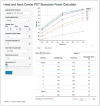A Bayesian framework for performance assessment and comparison of imaging biomarker quantification methods
- PMID: 29271301
- PMCID: PMC6045465
- DOI: 10.1177/0962280217741334
A Bayesian framework for performance assessment and comparison of imaging biomarker quantification methods
Abstract
Quantitative biomarkers derived from medical images are being used increasingly to help diagnose disease, guide treatment, and predict clinical outcomes. Measurement of quantitative imaging biomarkers is subject to bias and variability from multiple sources, including the scanner technologies that produce images, the approaches for identifying regions of interest in images, and the algorithms that calculate biomarkers from regions. Moreover, these sources may differ within and between the quantification methods employed by institutions, thus making it difficult to develop and implement multi-institutional standards. We present a Bayesian framework for assessing bias and variability in imaging biomarkers derived from different quantification methods, comparing agreement to a reference standard, studying prognostic performance, and estimating sample size for future clinical studies. The statistical methods are illustrated with data obtained from a positron emission tomography challenge conducted by members of the NCI's Quantitative Imaging Network program, in which tumor volumes were measured manually and with seven different semi-automated segmentation algorithms. Estimates and comparisons of bias and variability in the resulting measurements are provided along with an R software package for the technical performance analysis and an online web application for sample size and power analysis.
Keywords: Bayesian; Quantitative imaging biomarkers; agreement; bias; precision; sample size.
Conflict of interest statement
The author(s) declared no potential conflicts of interest with respect to the research, authorship, and/or publication of this article.
Figures



Similar articles
-
Multisite Technical and Clinical Performance Evaluation of Quantitative Imaging Biomarkers from 3D FDG PET Segmentations of Head and Neck Cancer Images.Tomography. 2020 Jun;6(2):65-76. doi: 10.18383/j.tom.2020.00004. Tomography. 2020. PMID: 32548282 Free PMC article.
-
Quantitative imaging biomarkers: Effect of sample size and bias on confidence interval coverage.Stat Methods Med Res. 2018 Oct;27(10):3139-3150. doi: 10.1177/0962280217693662. Epub 2017 Feb 27. Stat Methods Med Res. 2018. PMID: 29298603
-
Quantitative imaging biomarkers: a review of statistical methods for computer algorithm comparisons.Stat Methods Med Res. 2015 Feb;24(1):68-106. doi: 10.1177/0962280214537390. Epub 2014 Jun 11. Stat Methods Med Res. 2015. PMID: 24919829 Free PMC article. Review.
-
A unified framework for simultaneous assessment of accuracy, between-, and within-reader variability of image segmentations.Stat Methods Med Res. 2020 Nov;29(11):3135-3152. doi: 10.1177/0962280220920894. Epub 2020 May 20. Stat Methods Med Res. 2020. PMID: 32432517
-
Quantitative imaging biomarkers: a review of statistical methods for technical performance assessment.Stat Methods Med Res. 2015 Feb;24(1):27-67. doi: 10.1177/0962280214537344. Epub 2014 Jun 11. Stat Methods Med Res. 2015. PMID: 24919831 Free PMC article. Review.
Cited by
-
Multisite Technical and Clinical Performance Evaluation of Quantitative Imaging Biomarkers from 3D FDG PET Segmentations of Head and Neck Cancer Images.Tomography. 2020 Jun;6(2):65-76. doi: 10.18383/j.tom.2020.00004. Tomography. 2020. PMID: 32548282 Free PMC article.
-
The Use of Quantitative Imaging in Radiation Oncology: A Quantitative Imaging Network (QIN) Perspective.Int J Radiat Oncol Biol Phys. 2018 Nov 15;102(4):1219-1235. doi: 10.1016/j.ijrobp.2018.06.023. Epub 2018 Jun 30. Int J Radiat Oncol Biol Phys. 2018. PMID: 29966725 Free PMC article. Review.
References
-
- Pham DL, Xu C, Prince JL. Current methods in medical image segmentation. Ann Rev Biomed Eng. 2000;2:315–337. - PubMed
-
- Kessler LG, Barnhart HX, Buckler AJ, et al. The emerging science of quantitative imaging biomarkers terminology and definitions for scientific studies and regulatory submissions. Stat Meth Med Res. 2015;24:9–26. - PubMed
Publication types
MeSH terms
Substances
Grants and funding
LinkOut - more resources
Full Text Sources
Other Literature Sources

